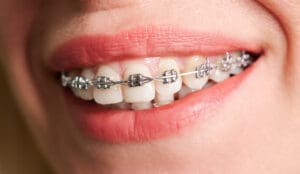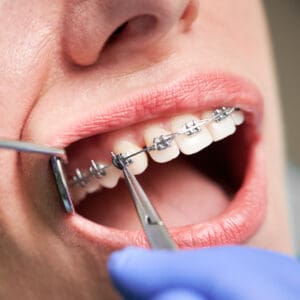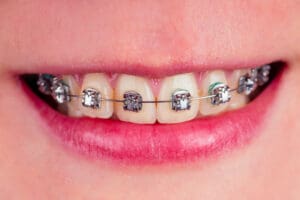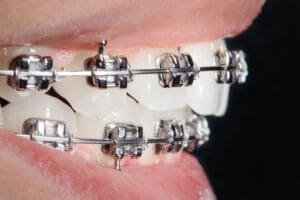
Traditional metal braces are a popular and effective way to straighten teeth and improve smiles. These braces use metal brackets and wires to gently move teeth into the desired position over time. They are known for their durability and ability to correct a wide range of dental issues.
Caring for traditional metal braces is straightforward, but it requires some adjustments to your daily routine. Regular dental check-ups and good oral hygiene are essential for achieving the best results.
If you’re ready to learn more about how traditional metal braces can transform your smile, contact Smilebliss today.
 The brace’s journey began long before the advent of modern orthodontics. The Etruscans, ancient inhabitants of Italy, crafted dental appliances to maintain space and prevent collapse of teeth after death, showcasing early human attempts at orthodontic care.
The brace’s journey began long before the advent of modern orthodontics. The Etruscans, ancient inhabitants of Italy, crafted dental appliances to maintain space and prevent collapse of teeth after death, showcasing early human attempts at orthodontic care.
Pierre Fauchard, often hailed as the father of contemporary orthodontics, revolutionized dental care in the 18th century. He introduced a device called the “bandeau,” a horseshoe-shaped piece of metal that helped expand the arch.
Edward Angle, an experienced orthodontist, made significant strides in the late 1800s. He developed the first simple classification system for malocclusions, which still guides orthodontic treatments today. His introduction of wire braces marked a pivotal moment in orthodontic advancements, laying the groundwork for modern orthodontic solutions.
The use of stainless steel in the 20th century was a game-changer for braces. It made them more affordable and accessible to a broader audience. This material also allowed for smaller, more comfortable designs, significantly improving the orthodontic journey for many patients.
Brackets act as the main anchor for braces. They attach to each tooth, holding the archwire that moves the teeth. Materials vary, from metal to ceramic. Ceramic brackets are less visible, making them a popular choice for those concerned about appearance.
Metal brackets are more traditional and durable. They withstand pressure well, making them suitable for severe corrections. Ceramic options offer an aesthetic advantage but may require more care.
The archwire plays a crucial role in the braces system. It connects to the brackets, applying constant pressure on the teeth. This pressure helps in gradually moving the teeth into the desired position.
Archwires need regular adjustments by orthodontists to ensure progress. These adjustments help in controlling the direction and amount of pressure, facilitating effective teeth movement.
Elastic ligatures and rubber bands are vital for braces’ functionality. Ligatures hold the archwire to the brackets, ensuring it stays in place. They come in various colors, allowing customization.
Rubber bands adjust jaw alignment and correct bite discrepancies. They connect to hooks on the brackets, applying force necessary for adjustments. Regular replacement of these elastic elements is essential for maintaining effective pressure.
 The journey to a better smile begins with attaching brackets directly to each tooth. These brackets act as anchors for the orthodontic wires that will guide teeth into their correct positions.
The journey to a better smile begins with attaching brackets directly to each tooth. These brackets act as anchors for the orthodontic wires that will guide teeth into their correct positions.
After securing the brackets, the next critical step involves threading the archwire through them. This wire is the backbone of traditional braces, applying constant pressure on the teeth.
Orthodontists then secure the archwire with tiny bands. These elements work together, creating the foundation for effective orthodontic treatment.
Orthodontic treatments require regular adjustments. During these visits, orthodontists tighten the archwire to apply gentle yet effective pressure on the teeth. This process gradually moves teeth into their desired positions. Each adjustment is a step closer to achieving optimal alignment and bite.
Adjustments are important for progress. They ensure that the pressure applied by the braces remains constant and effective throughout the treatment.
The duration of wearing braces varies significantly among individuals. It largely depends on the complexity of the orthodontic issues being addressed. Some may see improvements within a few months, while others might need years of treatment.
This individualized approach ensures that each patient receives the right braces for their specific needs. Whether it’s adult braces or alternatives, orthodontic solutions are tailored to achieve the best possible outcomes.
 Metal braces, known for their robust construction, stand out as a reliable choice for long-term orthodontic treatment. Unlike their ceramic counterparts, metal brackets are less likely to chip or crack. This resilience ensures that patients can undergo treatment without frequent visits for repairs, making traditional metal braces a preferred option for those with active lifestyles or complex dental issues.
Metal braces, known for their robust construction, stand out as a reliable choice for long-term orthodontic treatment. Unlike their ceramic counterparts, metal brackets are less likely to chip or crack. This resilience ensures that patients can undergo treatment without frequent visits for repairs, making traditional metal braces a preferred option for those with active lifestyles or complex dental issues.
When considering the financial aspect, metal braces present an attractive proposition. They are typically more affordable than discreet braces alternatives like clear aligners. For families or individuals mindful of budget constraints, this makes traditional metal braces a go-to solution for achieving a straighter smile without breaking the bank.
Recent years have seen significant improvements in the design and comfort of modern metal braces. The once-bulky braces have evolved into devices with small metal brackets, which not only reduce discomfort but also blend more seamlessly with the teeth. These advancements address some of the common concerns about aesthetics and pain, making today’s metal braces far more appealing than older models.
Traditional metal braces are a reliable way to straighten your teeth and improve your smile. At Smilebliss, we provide expert care and support throughout your orthodontic journey.
Metal braces are durable, effective, and suitable for all ages. Our team will ensure you understand every step and feel comfortable with your treatment.
Discover the benefits of traditional metal braces with Smilebliss today!
Traditional metal braces have seen significant advancements, transitioning from bulky, noticeable designs to sleeker, more comfortable configurations that effectively straighten teeth with less discomfort and in less time.
Traditional braces mainly consist of brackets, which are attached to each tooth, and archwires that connect the brackets. Small bands called ligatures hold the wire to the brackets, applying pressure to move teeth into place.
Metal braces work by applying continuous pressure to the teeth through the archwire and brackets. This pressure gradually moves the teeth into their correct positions over time, guided by adjustments made by an orthodontist.
Metal braces are highly effective for correcting complex dental issues. They offer reliability, durability, and a cost-effective solution compared to other orthodontic treatments. Plus, modern advances have made them more comfortable and aesthetically pleasing than ever before.
Most people can benefit from traditional metal braces, from children to adults. However, an orthodontic consultation is necessary to determine if they are the best option based on individual dental health and alignment needs.
Treatment duration varies depending on the complexity of the dental issues being corrected but generally ranges from 18 months to 3 years. Regular check-ups and adjustments are essential for achieving the desired results within this timeframe.
While there may be some discomfort after initial placement and during adjustments, modern metal braces are designed to minimize pain. Discomfort typically subsides within a few days after each adjustment.